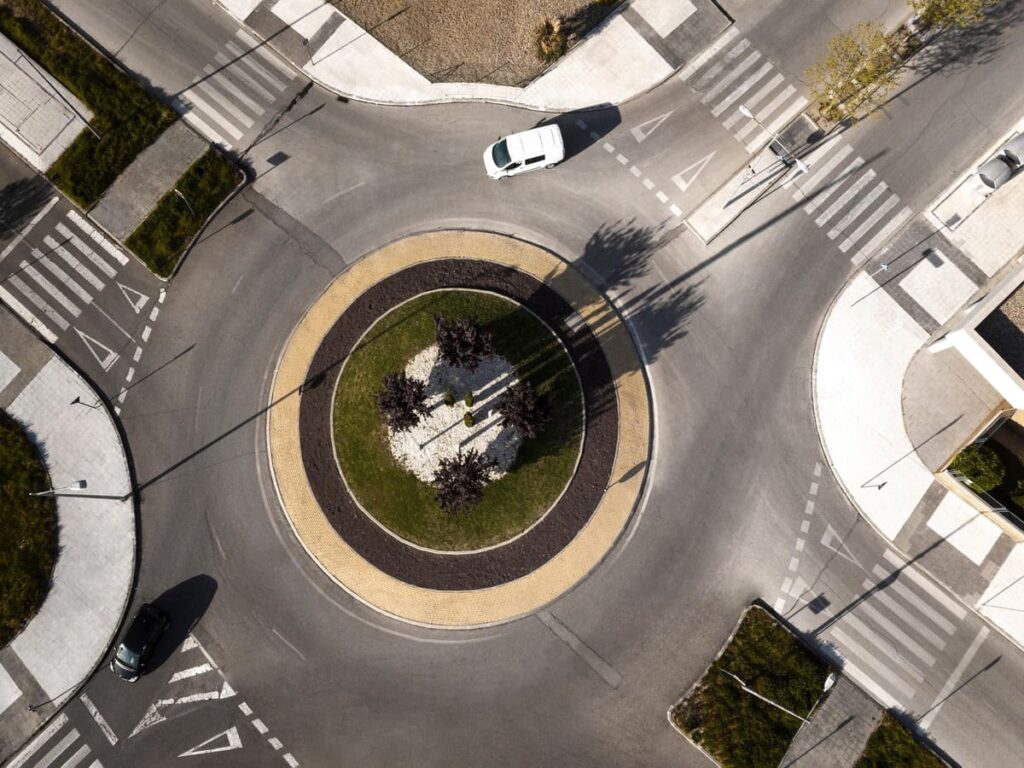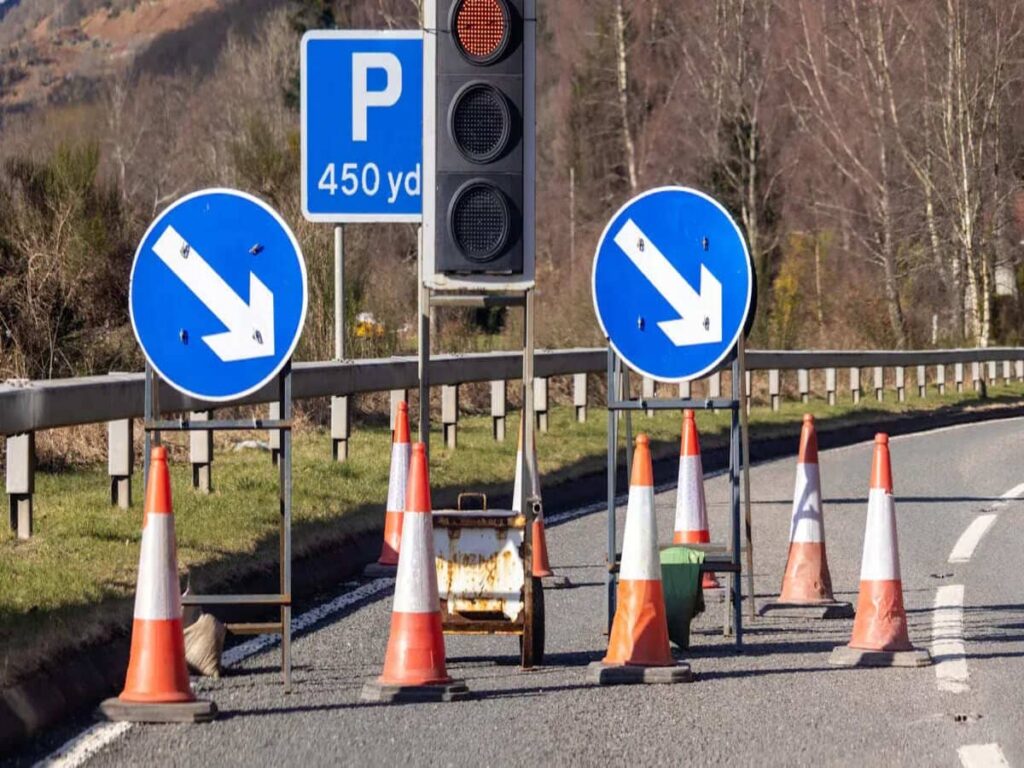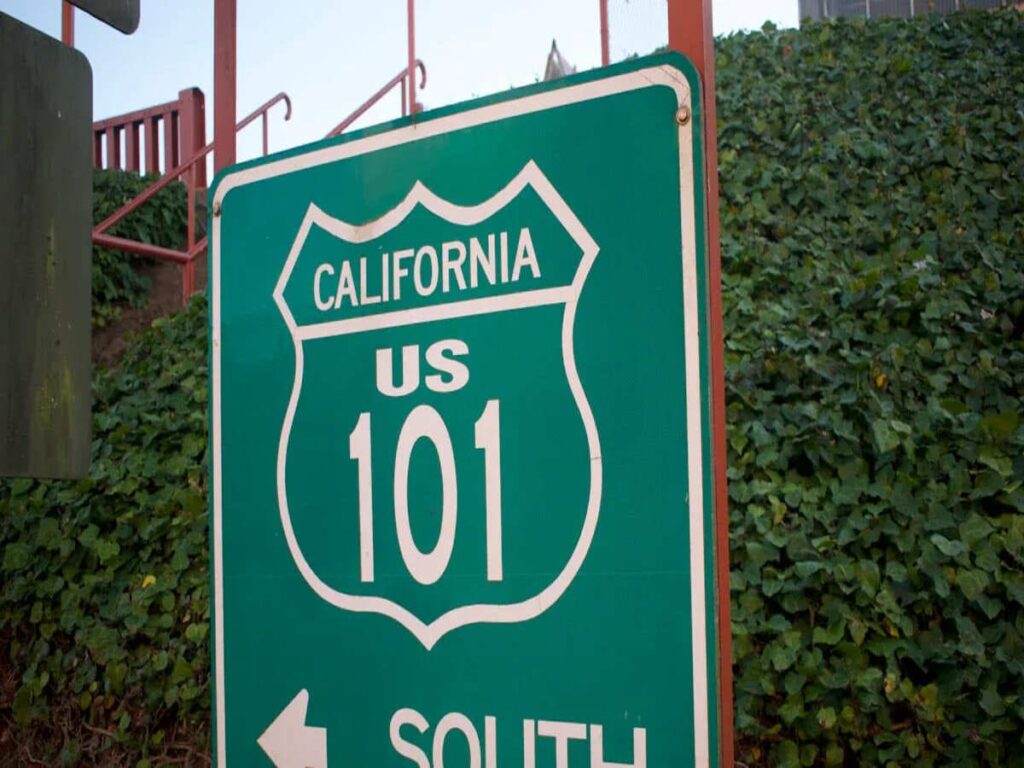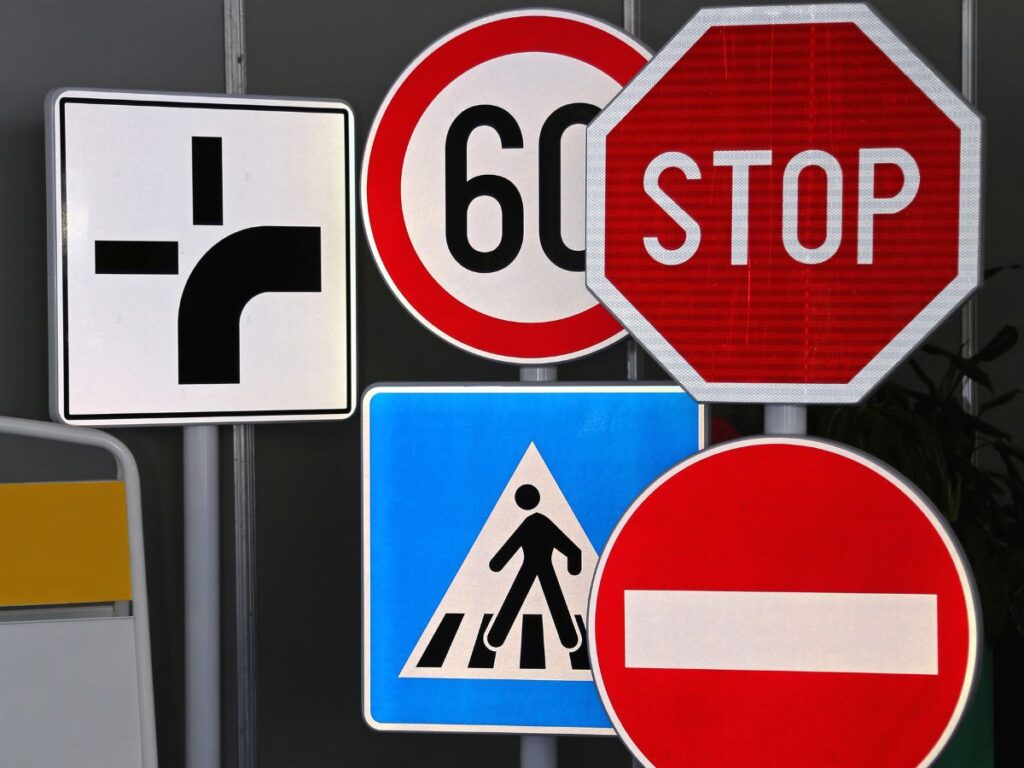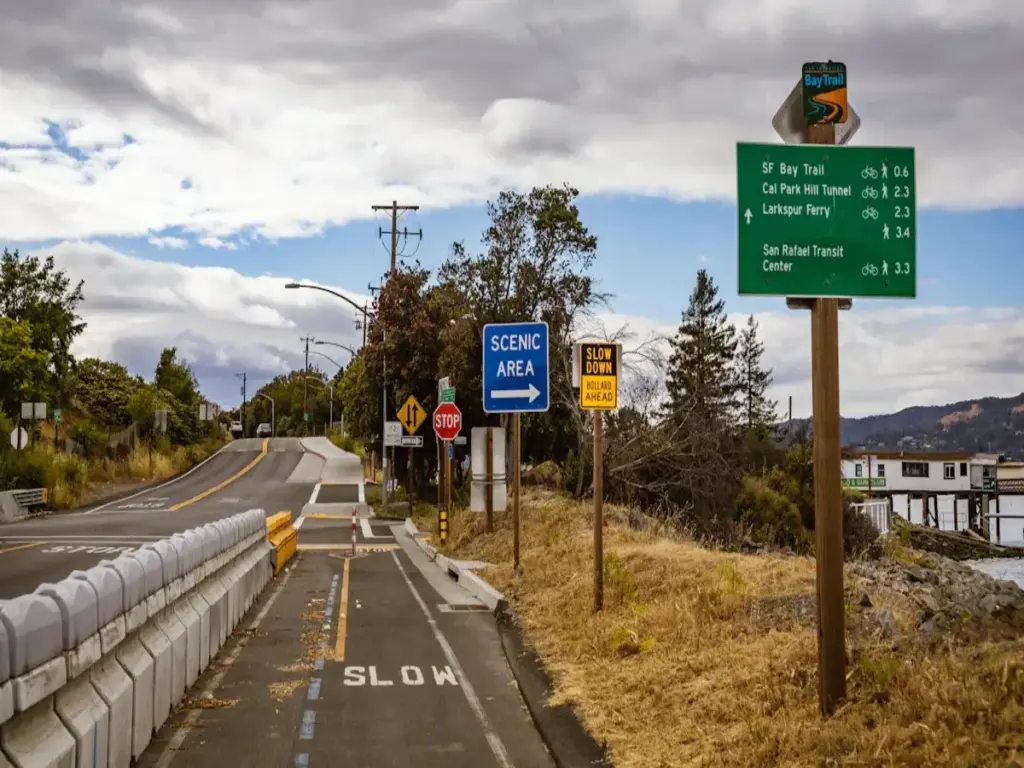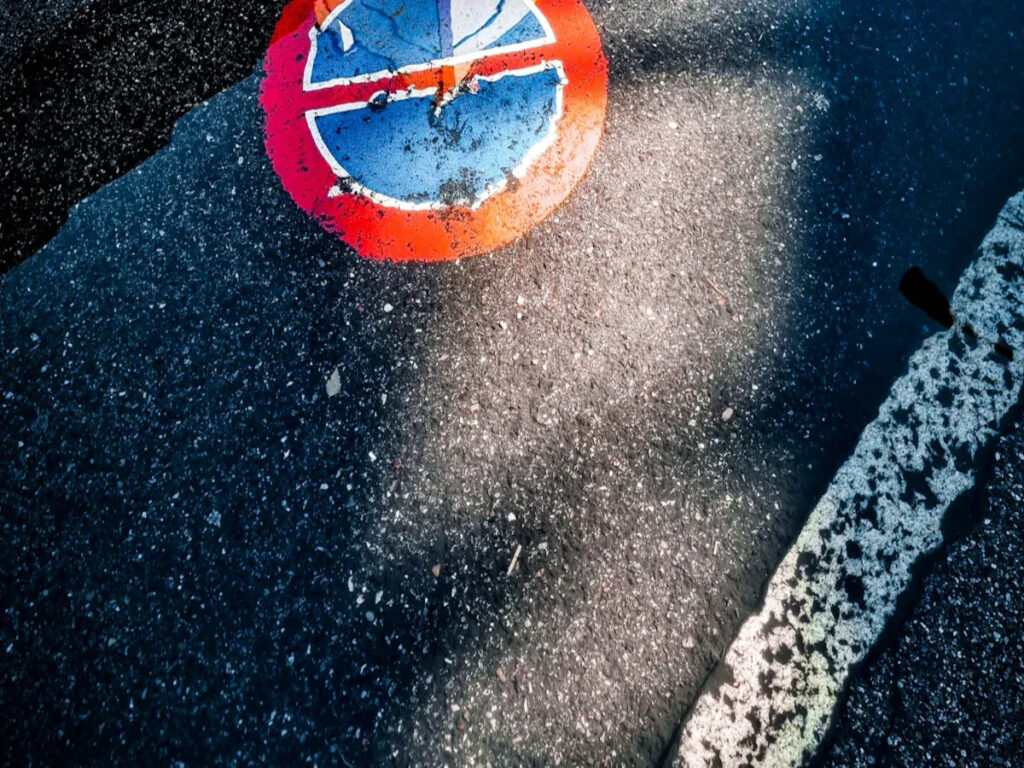
Autobahnschilder in Australien müssen gut sichtbar sein, um die Sicherheit aller Verkehrsteilnehmer zu gewährleisten. Ein Schlüsselfaktor für die Sichtbarkeit ist die Retroreflexion – die Fähigkeit eines Materials, Licht zurück zu seiner Quelle zu reflektieren. Diese Eigenschaft sorgt dafür, dass Verkehrsschilder auch nachts oder bei widrigen Wetterbedingungen klar und lesbar bleiben.
Durch die Verbesserung der Schildersichtbarkeit, Retroreflektierende Materialien geben dem Autofahrer mehr Zeit zum Reagieren, Verringerung des Unfallrisikos und Verbesserung der allgemeinen Verkehrssicherheit. Die australischen Vorschriften und fortlaufenden Innovationen drängen weiterhin auf eine bessere visuelle Leistung der Beschilderung im ganzen Land.
Bei OPTRAFFIC, Wir integrieren fortschrittliche Technologien in unsere Sicherheitsbeschilderung Lösungen, um die australischen Sichtbarkeitsstandards zu erfüllen und zu übertreffen, Straßen sicherer halten, Tag und Nacht.
Grundlagen der Retroreflexion
Was ist Retroreflexion?
Retroreflexion ist eine Eigenschaft einiger Materialien. Diese Materialien schicken das Licht dorthin zurück, wo es begonnen hat. Wenn die Scheinwerfer eines Autos auf ein Schild leuchten, Das Schild sendet das Licht an den Fahrer zurück. Dadurch ist das Schild nachts oder bei schlechtem Wetter viel besser zu erkennen. Technische Standards wie ASTM E1710 Erklären Sie, wie Sie die Retroreflexion überprüfen. Studien zeigen, dass Schilder mit stärkerer Retroreflexion dazu beitragen, nächtliche Unfälle zu verhindern. Dies zeigt, warum Retroreflexion wichtig für die Verkehrssicherheit und das klare Erkennen von Schildern ist.
Wie es funktioniert
Retroreflektierende Materialien bestehen aus winzigen Glasperlen oder Mikroprismen. Diese Teile fangen Licht ein und senden es auf dem gleichen Weg zurück, wie es gekommen ist. Das Design hält das Licht zusammen, So sehen Autofahrer schon von weitem helle Schilder. Tests an vielen Verkehrsschildern zeigen dieses Alter, Winkel, und der Materialtyp ändern das Retroreflexionsvermögen. Schilder können mit zunehmendem Alter an Retroreflexion verlieren, wodurch sie schwerer zu erkennen sind. Regelmäßige Kontrollen tragen dazu bei, dass die Schilder gut sichtbar und die Straßen sicher sind. In Labortests, Die oberen Glasperlen machten die Schilder für Fahrer und Sensoren leichter erkennbar, Auch bei Regen oder Nebel.
Notiz: Retroreflexion hilft Menschen und Maschinen, Schilder besser zu erkennen, auch wenn die Bedingungen schwierig sind.
Retroreflexion vs. Reflektivität
- Retroreflexion sendet Licht dorthin zurück, wo es herkommt, So sind die Schilder auch nachts gut zu erkennen.
- Regelmäßiges Reflexionsvermögen streut das Licht auf vielfältige Weise, Dies kann dazu führen, dass die Schilder aus einem fahrenden Auto heraus schwer zu erkennen sind.
- Verschiedene Arten von retroreflektierenden Folien (wie Typ I, III, VII, Ix) Geben Sie unterschiedliche Ebenen der Schildersichtbarkeit an. Die Typen VII und IX eignen sich am besten zum Lesen von Schildern in der Nacht.
- Luminanz, oder regelmäßiges Reflexionsvermögen, ist draußen schwieriger zu überprüfen, da es von Faktoren wie Scheinwerferwinkel und Hintergrundlicht abhängt.
- Retroreflexionsstandards werden häufiger verwendet, da sie einfacher zu überprüfen sind und einen direkten Bezug zur Sichtbarkeit von Schildern herstellen.
Wissenschaft und Materialien
Prinzipien der Lichtreflexion
Retroreflektierende Materialien nutzen die Wissenschaft, um Licht zurückzusenden. Wenn Scheinwerfer auf ein Schild treffen, Das Licht geht zurück zum Fahrer. Dafür sorgen winzige Glasperlen oder Prismen im Inneren des Schildes. Die Federal Highway Administration sagt, dass mehr Retroreflexion weniger Unfälle bedeutet. Dies beweist, dass die Rücksendung von Licht zur Sicherheit der Menschen beiträgt. 3M sagt, Glasperlen und Würfeleckenprismen biegen und reflektieren Licht. Dadurch bleiben die Schilder nachts hell. Langjährige Forschung zeigt, dass diese Materialien Autofahrern helfen, Schilder gut zu erkennen.
Materialien verwendet
Verschiedene Materialien tragen dazu bei, dass Schilder das Licht gut reflektieren. Am häufigsten sind Glasperlen, Mikroprimen, und Keramikperlen. Jeder Typ reflektiert das Licht gut und hält lange. Studien besagen, dass Glasperlenmaterialien billig und stark sind. Keramikperlen halten außerdem lange und reflektieren das Licht gut. Die folgende Tabelle zeigt die Haupttypen:
| Materialtyp | Retroreflexionsleistung | Erkenntnisse zur Haltbarkeit | Notizen |
|---|---|---|---|
| Retroreflektierendes Prisma | Bis zu 40% bei niedrigen Winkeln | Hält über 25 Monate; leicht zu reinigen | Am besten bei niedrigen Winkeln |
| Retroreflektierende Glasperlen | Um 20%; besser bei hohen Winkeln | Reflektiert danach 20 Jahre; kleiner Tropfen danach 1 Jahr | Gut für viele Zwecke |
| Kapsel retroreflektierend | Um 20%; Tropfen nach Außengebrauch | Fällt danach ab 25 Monate; Risse auf der Oberfläche | Nicht so stark |
Glasabdeckungen können dazu beitragen, dass Schilder länger halten, indem sie Witterungsschäden verhindern. Durch die Auswahl des richtigen Materials bleiben Schilder über Jahre hinweg gut sichtbar.
Fortschritte in der Technologie
Retroreflektierende Schilderfolien haben sich im Laufe der Zeit stark verändert. Auf alten Schildern wurden Glasperlen verwendet, Aber jetzt machen Mikroprismen Schilder noch heller. Neue Forschungsergebnisse nutzen maschinelles Lernen, um zu wissen, wann Zeichen verblassen. Dies hilft Arbeitern, Schilder auszutauschen, bevor sie zu langweilig werden. Einige neue Filme können nachts ihre Farbe ändern. Dadurch sind die Schilder für Autofahrer und Passanten besser erkennbar. Teams aus verschiedenen Bereichen arbeiten zusammen, um Schilder besser zu machen. Diese Änderungen tragen dazu bei, dass die Schilder hell und für alle sicher bleiben.
Straßenschilder und Sichtbarkeit
Sicherheit bei Nacht
Straßenschilder müssen auch nach Einbruch der Dunkelheit gut erkennbar sein. Retroreflektierende Materialien sorgen dafür, dass Schilder leuchten, wenn sie von Scheinwerfern getroffen werden. Autofahrer können diese Schilder schon von weitem erkennen, sogar spät in der Nacht. Diese Helligkeit gibt dem Fahrer mehr Zeit, das Schild zu lesen. Viele Straßen in Australien führen durch Landgebiete mit wenig Licht. Retroreflektierende Schilder helfen dabei, Autofahrer an diesen Stellen sicher zu leiten. Wenn die Zeichen nachts klar sind, Es ist weniger wahrscheinlich, dass Autofahrer Abbiegungen verpassen oder plötzlich anhalten. Straßen sind sicherer, wenn Autofahrer die Schilder frühzeitig erkennen.
Wetterbedingungen
Regen, Nebel, und Nebel kann das Fahren erschweren. Retroreflektierende Autobahnschilder bleiben auch bei schlechtem Wetter hell. Forscher untersuchten, wie das Wetter die Sichtbarkeit von Schildern verändert. Sie fanden heraus, dass retroreflektierende Folienschilder auch bei Regen und Nebel hell blieben. Andere Schildermaterialien verloren an Helligkeit, besonders bei starkem Regen oder dichtem Nebel. Die Studie zeigte, dass Regen und schlechte Sicht die Wahrnehmung von Schildern durch Fahrer und Sensoren verändern. Manchmal, Wassertropfen auf Schildern können diese für kurze Zeit heller erscheinen lassen. Diese Ergebnisse zeigen, dass retroreflektierende Schilder dazu beitragen, die Straßen bei jedem Wetter sicher zu halten. Autofahrer vertrauen darauf, dass ihnen diese Schilder den Weg durch Sturm und Nebel weisen.
Fahrerantwort
Autofahrer brauchen Zeit, um auf das zu reagieren, was sie sehen. Retroreflektierende Verkehrsschilder geben klare Warnungen und Anweisungen. Wenn Zeichen auffallen, Autofahrer können langsamer werden, stoppen, oder sicher abbiegen. Das schnelle Erkennen von Schildern bedeutet, dass Fahrer keine wichtigen Nachrichten verpassen. In Australien, Studien zeigen, dass eine bessere Sichtbarkeit der Schilder nachts und bei schlechtem Wetter zu weniger Unfällen führt. Zum Beispiel, nachdem an einer stark befahrenen Landstraße neue retroreflektierende Schilder angebracht wurden, Es gab weniger nächtliche Unfälle. Die Fahrer sagten, sie fühlten sich sicherer und selbstbewusster. Eine gute Sichtbarkeit der Schilder hilft allen, sogar ältere Fahrer, denen es nachts schwerfällt, etwas zu sehen. Auch Fußgänger und Radfahrer profitieren, weil Autofahrer sie früher bemerken. Für die Verkehrssicherheit kommt es darauf an, den Fahrern genügend Zeit zum Reagieren zu geben.
Tipp: Regelmäßige Kontrollen und Reinigung tragen dazu bei, dass retroreflektierende Schilder einwandfrei funktionieren, besonders nach Stürmen oder langem Trockenwetter.
Australische Standards
Als/nzs 1906.1
Als/nzs 1906.1 legt die Hauptregeln für reflektierende Materialien fest, die auf australischen Verkehrsschildern verwendet werden. Dieser Standard stellt sicher, dass Schilder auch nachts oder bei schlechtem Wetter hell und gut erkennbar bleiben. Für Schilder müssen Materialien verwendet werden, die über viele Jahre ihren Glanz und ihre Festigkeit behalten. Der Standard prüft die Farbe, Helligkeit, und wie gut das Material Regen standhält, Hitze, und tragen. Schilder, die AS/NZS entsprechen 1906.1 sind gut lesbar und halten länger, selbst bei rauem australischem Wetter.
MUTCD -Richtlinien
Der Handbuch für einheitliche Verkehrssteuerungsgeräte (MUTCD) enthält zusätzliche Regeln für Verkehrszeichen in Australien. MUTCD begann in den 2000er Jahren mit der Verwendung reflektierender Materialien. Dadurch kann jede Region einige Regeln ändern, um sie an die lokalen Bedürfnisse anzupassen, wie Küsten- oder Schneegebiete. Als/nzs 1906.1 wendet eine strenge Regel für ganz Australien an, aber MUTCD ermöglicht eine gewisse Flexibilität. Dies trägt dazu bei, dass Verkehrszeichen an verschiedenen Orten gut funktionieren. Die folgende Tabelle zeigt, wie sich die Dinge nach diesen Standards verändert haben:
| Besonderheit | Vor Änderungen | Nach Änderungen |
|---|---|---|
| Reflexionsvermögen | Nachts waren die Schilder schwer zu erkennen | Schilder sind jederzeit gut zu erkennen, Treffen mit AS/NZS 1906.1 Standards |
| Meldung Klarheit | Die Nachrichten waren überfüllt und verwirrend | Die Nachrichten sind einfach und klar |
| Haltbarkeit | Schilder wurden durch schlechtes Wetter beschädigt | Die Schilder sind stabil und witterungsbeständig |
Notiz: Als/nzs 1906.1 sorgt für ein höheres und gleichmäßigeres Sicherheitsniveau für alle Verkehrsteilnehmer.
Reflektierende Materialklassen
Reflektierende Materialien Straßenschilder gibt es in drei Hauptklassen. Jede Klasse hat ihr eigenes Nutzungs- und Sicherheitsniveau.
- Klasse 1 Funktioniert am besten für Bereiche mit niedriger Geschwindigkeit, wie Parkplätze oder Lagerhallen.
- Klasse 2 ist für Straßen mit schnellerem Verkehr, B. Stadtstraßen oder Baustellenbereiche.
- Klasse 3 Bietet die höchste Helligkeit und wird auf Autobahnen oder an Orten mit schlechter Sicht verwendet.
Die folgende Tabelle zeigt die Hauptunterschiede:
| Klasse | Beabsichtigte Verwendung / Verkehrsgeschwindigkeit | Minimale retroreflektierende Fläche | Mindestbreite des Materials |
|---|---|---|---|
| Klasse 1 | Niedrige Geschwindigkeit (≤ 25 Meilen pro Stunde), Z.B., Parkplätze | 155 in² | 1 Zoll |
| Klasse 2 | Höhere Geschwindigkeit (> 25 Meilen pro Stunde), Z.B., Stadtstraßen | 201 in² | 1.38 Zoll |
| Klasse 3 | Hohe Geschwindigkeit (> 50 Meilen pro Stunde), Autobahnen, schlechte Sichtbarkeit | 310 in² | 2 Zoll |
Klasse 3 Materialien muss die härtesten Helligkeitstests bestehen, Farbe, und Stärke. Diese Regeln sorgen dafür, dass Verkehrszeichen sicher und gut sichtbar bleiben, Egal wo sie sind.
Auswirkungen auf die Verkehrssicherheit
Unfallverhütung
Retroreflektierende Verkehrsschilder helfen, Unfälle zu verhindern. Mit diesen Schildern können Autofahrer wichtige Dinge schnell erkennen, sogar nachts oder bei schlechtem Wetter. Wenn Autofahrer frühzeitig Anzeichen erkennen, Sie können langsamer werden oder sicher anhalten. Dies verringert die Wahrscheinlichkeit von Unfällen auf stark befahrenen Straßen oder in scharfen Kurven. Die Federal Highway Administration untersuchte Kreuzungen in Connecticut und South Carolina. Sie fanden heraus, dass hellere STOP-Schilder zu weniger Auffahrunfällen und weniger Unfällen an Kreuzungen führten. Die größten Veränderungen gab es an Orten mit weniger Verkehr. Die Studie zeigte auch, dass Fahrer durch eine höhere Retroreflexion Schilder aus größerer Entfernung erkennen können, was Straßen sicherer macht.
Fallstudien
Australische Straßen sind durch retroreflektierende Schilder sicherer geworden. Zum Beispiel, nachdem auf einer Landstraße in Victoria neue Schilder angebracht wurden, Es kam zu nächtlichen Unfällen. Lokalräte sagten, Autofahrer reagierten schneller auf Warnschilder, was plötzliche Stopps und Abstürze stoppte. In Queensland, Verkehrssicherheitsteams verzeichneten durch die Verwendung hellerer Schilder weniger Unfälle an Kreuzungen. Diese Ergebnisse stimmen mit den Ergebnissen ausländischer Studien überein, Es zeigt, dass eine bessere Sichtbarkeit der Schilder die Straßen für alle sicherer macht.
Notiz: Klare und helle Schilder geben den Fahrern mehr Zeit, sichere Entscheidungen zu treffen, insbesondere bei schlechten Lichtverhältnissen.
Vorteile für die Gemeinschaft
Retroreflektierende Schilder helfen nicht nur Autofahrern. Auch Fußgänger und Radfahrer sind sicherer, wenn Verkehrsschilder gut erkennbar sind. Wenn Autofahrer Schilder frühzeitig erkennen, Sie können auf Menschen achten, die die Straße überqueren oder Fahrrad fahren. Durch diese zusätzliche Zeit ist jeder auf der Straße sicherer unterwegs. Schulen und Stadtteile mit besserer Beschilderung haben weniger Beinaheunfälle und fühlen sich sicherer. Rettungsdienste können schneller Adressen finden und helfen, wenn Schilder gut sichtbar sind. Eine gute Sichtbarkeit der Schilder trägt dazu bei, dass sich jeder in seiner Gemeinde sicherer und selbstbewusster fühlt.
Wartung und zukünftige Trends
Zeichenverschlechterung
Australische Straßenschilder sind hartem Wetter ausgesetzt. Sonne, Regen, und Staub beschädigen retroreflektierende Oberflächen langsam. Im Laufe der Zeit, signs get less bright and harder to see at night. Road workers use retroreflectometers to check how much light signs reflect. These tools compare signs to standards like AS/NZS 1906.1 und und 12899-1. New retroreflectometers with DELTA technology are very accurate and easy to use outside. Some teams use mobile LIDAR and computer vision to check many signs fast, auch bei Tageslicht. Regular checks help keep signs bright and safe for everyone.
Tipp: Washing signs after storms or bushfires helps them stay clear and last longer.
New Technologies
Retroreflective technology keeps getting better. Zu den jüngsten Verbesserungen gehören::
- Mikroprismatische Bleche, wie Diamond Grad DG3, makes signs brighter and removes dark spots.
- Smart materials with sensors can change reflectivity for weather or traffic.
- Signs now link with cars and smart city systems using IoT technology.
- Automatisierte Fahrzeuge können Schilder mit neuen retroreflektierenden Folien besser lesen.
- Additive Fertigung und 3D-Druck ermöglichen individuelle Schilderformen und -merkmale.
- KI-gesteuerte Analysen können erkennen, wann Schilder ersetzt werden müssen, Zeit und Geld sparen.
Intelligente Schilder nutzen GPS und GIS für die Kartierung und Verfolgung. Automatisierte Fahrzeuge können den Schilderzustand während der Fahrt überprüfen. Diese Änderungen tragen dazu bei, die Straßen sicherer zu machen und die Pflege der Schilder zu erleichtern.
Nachhaltigkeit
Nachhaltigkeit ist für zukünftige Verkehrszeichen wichtig. Neue umweltfreundliche Materialien tragen zum Schutz der Umwelt bei. Einige retroreflektierende Folien verwenden recycelte Inhalte oder aus Pflanzen hergestellte Kunststoffe. Studien zeigen, dass diese Materialien auch nach Jahren der Sonne und dem Regen hell bleiben. Retroreflektierende Oberflächen können auch zur Kühlung von Städten beitragen, indem sie das Sonnenlicht reflektieren, was den Energieverbrauch in Gebäuden senkt. Viele Städte entscheiden sich mittlerweile für Schilder, die länger halten und bei der Herstellung weniger Energie verbrauchen.
Der Markt für retroreflektierende Materialien wächst weiter. Der asiatisch-pazifische Raum wächst am schnellsten, dann Nordamerika und Europa. Die folgende Tabelle zeigt die 2023 Umsatzanteil nach Region:

Die Hersteller setzen jetzt auf Smart, stark, und grüne Lösungen. Diese Trends bedeuten sicherere und sauberere Straßen für alle.
Retroreflexion hilft Autofahrern, nachts Autobahnschilder zu erkennen. Dies hält die Straßen sicherer für alle. Regelmäßige Kontrollen und strenge Regeln sorgen dafür, dass die Schilder bei jedem Wetter leuchten.
- Untersuchungen zeigen, dass eine bessere Retroreflexion in belebten Stadtgebieten die Zahl der nächtlichen Unfälle verringert.
- Neue Studien helfen dabei, Regeln zu aktualisieren, wenn die Technologie besser wird.
Der Einsatz neuer Materialien und intelligenter Werkzeuge wird dazu beitragen, dass Schilder den heutigen Anforderungen gerecht werden. Australiens Straßen werden sicherer, wenn neue Ideen wachsen und die Menschen klarere Schilder wünschen.
FAQ
Was unterscheidet retroreflektierende Schilder von normalen reflektierenden Schildern??
Retroreflektierende Schilder schicken das Licht dorthin zurück, wo es begonnen hat, wie Auto -Scheinwerfer. Regelmäßige reflektierende Schilder streuen das Licht in viele Richtungen. Autofahrer können retroreflektierende Schilder nachts besser erkennen.
Wie oft sollten Verkehrszeichen auf Retroreflexion überprüft werden??
Experten sagen, dass die Schilder alle zwei bis drei Jahre überprüft werden sollten. Regelmäßige Kontrollen sorgen dafür, dass die Schilder hell und gut sichtbar sind. Räte verwenden spezielle Werkzeuge, um die Retroreflexion zu testen.
Warum sehen manche Schilder nachts heller aus als andere??
Schilder werden aus unterschiedlichen Materialien und Klassen hergestellt. Klasse 3 Materialien sind die hellsten. Autobahnen nutzen diese häufig zur besseren Sichtbarkeit. Wetter und Alter können die Helligkeit eines Schildes verändern.
Können retroreflektierende Schilder bei nebligem oder regnerischem Wetter helfen??
Ja, Retroreflektierende Schilder bleiben auch bei Nebel und Regen hell. Die speziellen Materialien senden Licht an den Fahrer zurück, Auch wenn es schwer zu sehen ist. Dies hilft den Fahrern, sicher zu bleiben und ihren Weg zu finden.

